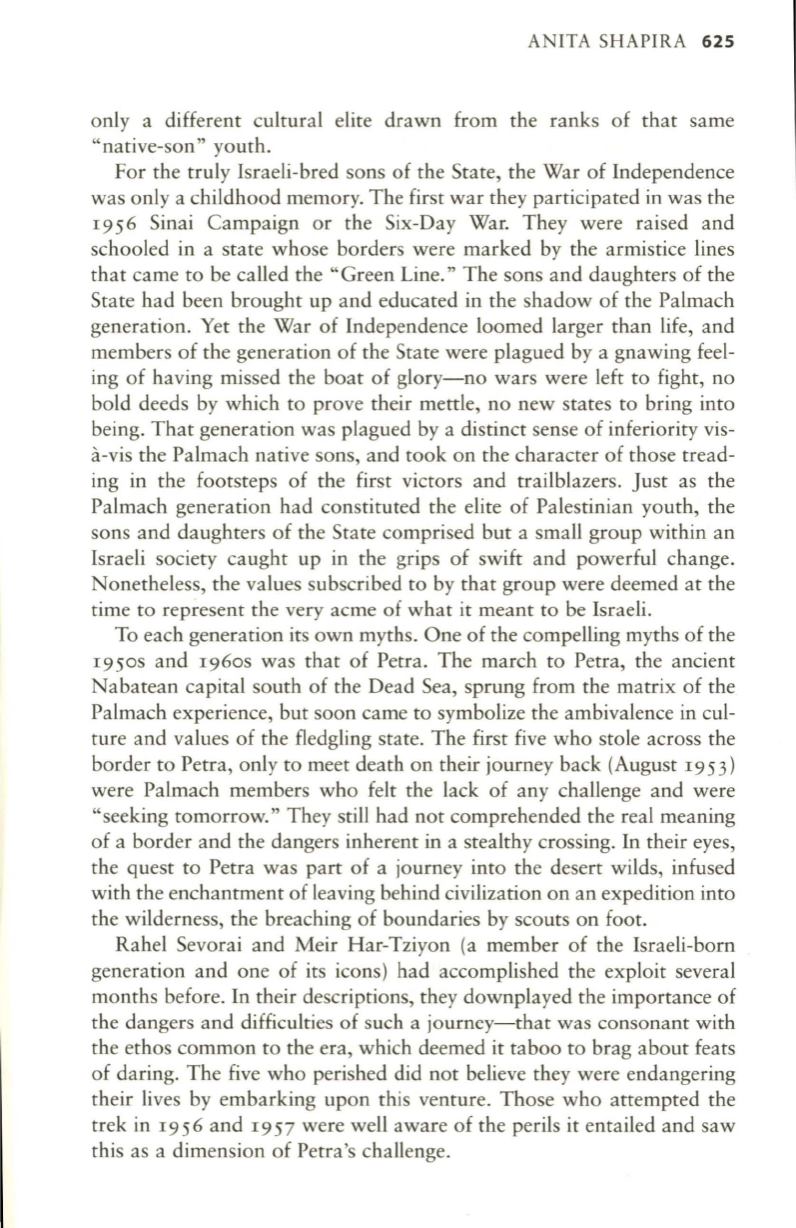
ANITA SHAPIRA
625
only a different cultural elite drawn from the ranks of that same
"native-son" youth.
For the truly Israeli-bred sons of the State, the War of Independence
was only a childhood memory. The first war they participated in was the
1956 Sinai Campaign or the Six-Day War. They were raised and
schooled in a state whose borders were marked by the armistice lines
that came to be called the "Green Line." The sons and daughters of the
State had been brought up and educated in the shadow of the Palmach
generation. Yet the War of Independence loomed larger than life, and
members of the generation of the State were plagued by a gnawing feel–
ing of having missed the boat of glory-no wars were left to fight, no
bold deeds by which to prove their mettle, no new states to bring into
being. That generation was plagued by a distinct sense of inferiority vis–
a-vis the Palmach native sons, and took on the character of those tread–
ing in the footsteps of the first victors and trailblazers. Just as the
Palmach generation had constituted the elite of Palestinian youth, the
sons and daughters of the State comprised but a small group within an
Israeli society caught up in the grips of swift and powerful change.
Nonetheless, the values subscribed to by that group were deemed at the
time to represent the very acme of what it meant to be Israeli.
To each generation its own myths. One of the compelling myths of the
1950S and 1960s was that of Petra. The march to Petra, the ancient
Nabatean capital south of the Dead Sea, sprung from the matrix of the
Palmach experience, but soon came to symbolize the ambivalence in cul–
ture and values of the fledgling state. The first five who stole across the
border to Petra, only to meet death on their journey back (August 1953)
were Palmach members who felt the lack of any challenge and were
"seeking tomorrow." They still had not comprehended the real meaning
of a border and the dangers inherent in a stealthy crossing. In their eyes,
the quest to Petra was part of a journey into the desert wilds, infused
with the enchantment of leaving behind civilization on an expedition into
the wilderness, the breaching of boundaries by scouts on foot.
Rahel Sevorai and Meir Har-Tziyon (a member of the Israeli-born
generation and one of its icons) had accomplished the exploit several
months before. In their descriptions, they downplayed the importance of
the dangers and difficulties of such a journey-that was consonant with
the ethos common to the era, which deemed it taboo to brag about feats
of daring. The five who perished did not believe they were endangering
their lives by embarking upon this venture. Those who attempted the
trek in 1956 and 1957 were well aware of the perils it entailed and saw
this as a dimension of Petra's challenge.


